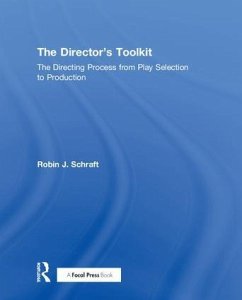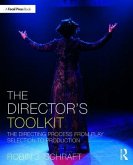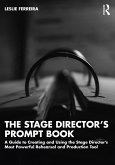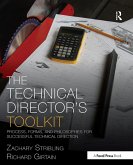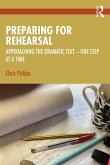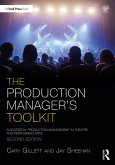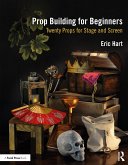Robin Schraft
The Director's Toolkit
Robin Schraft
The Director's Toolkit
- Gebundenes Buch
- Merkliste
- Auf die Merkliste
- Bewerten Bewerten
- Teilen
- Produkt teilen
- Produkterinnerung
- Produkterinnerung
The Director's Toolkit follows the directing process from start to finish covering each phase of the production process. Beginning with the selection and analysis of the script and ending with how to self-evaluate a production, chapters include thought-provoking activities, supplemented by resources on a companion website.
Andere Kunden interessierten sich auch für
![The Director's Toolkit The Director's Toolkit]() Robin SchraftThe Director's Toolkit86,99 €
Robin SchraftThe Director's Toolkit86,99 €![The Stage Director's Prompt Book The Stage Director's Prompt Book]() Leslie FerreiraThe Stage Director's Prompt Book55,99 €
Leslie FerreiraThe Stage Director's Prompt Book55,99 €![The Technical Director's Toolkit The Technical Director's Toolkit]() Zachary StriblingThe Technical Director's Toolkit37,99 €
Zachary StriblingThe Technical Director's Toolkit37,99 €![Preparing for Rehearsal Preparing for Rehearsal]() Chris PicklesPreparing for Rehearsal49,99 €
Chris PicklesPreparing for Rehearsal49,99 €![The Dance and Opera Stage Manager's Toolkit The Dance and Opera Stage Manager's Toolkit]() Susan Fenty StudhamThe Dance and Opera Stage Manager's Toolkit51,99 €
Susan Fenty StudhamThe Dance and Opera Stage Manager's Toolkit51,99 €![The Production Manager's Toolkit The Production Manager's Toolkit]() Cary GillettThe Production Manager's Toolkit72,99 €
Cary GillettThe Production Manager's Toolkit72,99 €![Prop Building for Beginners Prop Building for Beginners]() Eric Hart (Professional Prop Builder, New York, NY, USA)Prop Building for Beginners53,99 €
Eric Hart (Professional Prop Builder, New York, NY, USA)Prop Building for Beginners53,99 €-
-
-
The Director's Toolkit follows the directing process from start to finish covering each phase of the production process. Beginning with the selection and analysis of the script and ending with how to self-evaluate a production, chapters include thought-provoking activities, supplemented by resources on a companion website.
Hinweis: Dieser Artikel kann nur an eine deutsche Lieferadresse ausgeliefert werden.
Hinweis: Dieser Artikel kann nur an eine deutsche Lieferadresse ausgeliefert werden.
Produktdetails
- Produktdetails
- The Focal Press Toolkit Series
- Verlag: Taylor & Francis Ltd
- Seitenzahl: 362
- Erscheinungstermin: 24. Januar 2018
- Englisch
- Abmessung: 236mm x 191mm x 25mm
- Gewicht: 944g
- ISBN-13: 9781138095229
- ISBN-10: 1138095222
- Artikelnr.: 51134382
- Herstellerkennzeichnung
- Libri GmbH
- Europaallee 1
- 36244 Bad Hersfeld
- gpsr@libri.de
- The Focal Press Toolkit Series
- Verlag: Taylor & Francis Ltd
- Seitenzahl: 362
- Erscheinungstermin: 24. Januar 2018
- Englisch
- Abmessung: 236mm x 191mm x 25mm
- Gewicht: 944g
- ISBN-13: 9781138095229
- ISBN-10: 1138095222
- Artikelnr.: 51134382
- Herstellerkennzeichnung
- Libri GmbH
- Europaallee 1
- 36244 Bad Hersfeld
- gpsr@libri.de
Dr. Robin Schraft is a Professor of Theatre at Drury University. His commercial career includes work as a director, designer, and stage manager in New York, summer stock, national tours, and Branson, Missouri. He is a member of the Stage Directors and Choreographers Society (SDC) and the United States Institute for Theatre Technology (USITT), where he served for many years as the Vice-Commissioner for Computer Applications for the Lighting Commission of the Institute. He also served on the committee that wrote the current national recommended practices for stage lighting graphics.
Contents
Preface
Acknowledgments
Introduction - What Is a Director?
Background
The Director in the Production Process
The Function of the Director
Approaches
Director vs. Acting Coach
Qualities of a Good Director
The Production Process
A Final Thought
Further Exploration
PART I - The Script
Chapter 1 - Script Selection
Script Selection Process
Sources for Play Scripts
Understanding and Obtaining Performance Rights
Relationship with the Playwright
Contractual and Ethical Obligations
Preparing a Production Book
Play Selection Checklist
Further Exploration
Chapter 2 - Understanding the Play: Script Analysis
Understanding the Play
Determining and Understanding the Spine of the Play
Identifying the Dramatic Structure of the Play
Dividing the Script into Working Units
Analyzing the Play
Determining the Style of the Play
Script Analysis Format
Outline of Script Analysis Format
Further Exploration
Chapter 3 - Research Leading to a Concept
Analysis to Research
Production Research
Period Research
Background Research
Character Research
Playwright Research
Style Research
Final Thoughts on Research
Intrinsic and Extrinsic Interpretations of the Play
Historical and Social Implications in Interpretation of the Play
Developing a Production Concept for the Play
Research Leading to a Concept Checklist
Further Exploration
Chapter 4 - Style
What Is Style?
The Origin of Theatrical Styles
Modern Theatrical Styles
Determining the Style of the Play
Style vs. Mode
Determining the Mode for the Production
Further Exploration
PART II - The Production Staff
Chapter 5 - Working with the Production Staff
The Role of the Designers
The Director's Relationship with the Designers
Contributions of the Designers
Collaboration
Directing the Design Areas
Production Meetings
A Final Thought
Further Exploration
Chapter 6 - Working with the Stage Manager
The Stage Manager's Role in the Production
The Stage Manager's Functions
The Care and Feeding of Your Stage Manager
What the Stage Manager Is Not
Further Exploration
PART III - Auditions and Casting
Chapter 7 - Auditions
Purpose of Auditions
Types of Auditions
Procedures for Auditions
Planning for the Audition
The Use of Callback Auditions
How to Improve the Quality of the Auditions
Methods for Keeping Notes on the Actors
Director's Decorum
Audition Checklist
Sample Audition Procedures
Sample Audition Form
Sample Audition Worksheet
Further Exploration
Chapter 8 - Casting
The Importance of Casting Decisions
Criteria for Cast Selection
The Process of Making Casting Decisions
Nontraditional Casting
Understudies
Changing Your Mind
Casting with Other Directors
Casting Worksheet
Further Exploration
Chapter 9 - Scheduling for the Production
Planning
The Production Calendar
The Rehearsal Calendar - Preplanning vs. Daily Schedules
Planning the Amount of Time Needed
Phases
Establishing Goals for Each Rehearsal
Presenting the Production and Rehearsal Schedules
Final Thoughts
Scheduling Checklist
Further Exploration
PART IV - Floor Plans, Stage Pictures, and Blocking
Chapter 10 - Developing the Floor Plan
The Director's Relationship to the Floor Plan
Understanding Theater Architecture and Its Implications for the Production
Working with the Scenic Designer on Developing the Floor Plan
Types of Floor Plans (Patterns of Scenery)
Meeting the Needs of the Script
Using the Floor Plan to Focus the Audience's Attention
Mark Antony's Funeral Speech
Creating Visual Interest Using the Scenic Axis
Balance
Suggestions for Improving the Floor Plan
Using Key Scenes to Develop or Evaluate the Floor Plan
Drawing the Floor Plan
Floor Plan Development Checklist
Further Exploration
Chapter 11 - Creating Stage Pictures
What Is a Stage Picture?
The Process of Developing Stage Pictures
Developing a Stage Picture for Ile
Summary
Final Thoughts
Stage Picture Checklist
Further Exploration
Chapter 12 - Blocking
Preplanned vs. Organic Blocking
Purpose for Blocking
Principles of Blocking
Using Blocking More Effectively
Keeping the Blocking Motivated
Blocking Pitfalls to Avoid
Using Props
Planning, Recording, and Communicating the Blocking
Blocking Checklist
Further Exploration
PART V - The Rehearsal Process
Chapter 13 - Working with the Actors
Developing a Relationship with Your Actors
Types and Functions of Characters
Understanding the Actor's Process
Communicating with Your Actors
Working with Actorisms
Further Exploration
Chapter 14 - Rehearsal Techniques
Planning for the Rehearsals
Organization of the Rehearsals
Keeping Rehearsals on Task
Giving the Actors Notes
Keeping Muscle Memory in Mind
Rehearsing Scenes Involving Violence
Acting Exercises to Address Particular Needs
Rehearsal Organization Checklist
Further Exploration
Chapter 15 - Rehearsal Challenges
Challenges vs. Problems
Situations
Summary
Problem Solving Checklist
Further Exploration
Chapter 16 - Tempo, Rhythm, and Pace
The Director's Relationship to Tempo, Rhythm, and Pace
Tempo
Rhythm
Pace
Uniting Tempo and Rhythm to Create Pace in the Production
Technical Implications on Pace
Tools and Considerations for Building the Tempo, Rhythm, and Pace of the
Production
Pace and Energy
Tempo, Rhythm, and Pace Exercises
Final Thoughts
Further Exploration
Chapter 17 - Polishing the Play
The Function of the Polishing Rehearsals
Polishing the Acting
Implementing the Technical Aspects into the Production
Technical Rehearsals without the Actors (Dry Techs)
Technical Rehearsals with the Actors (Actor Techs)
Dress Rehearsals
Staging and Rehearsing the Curtain Call
Final Thoughts
Further Exploration
Chapter 18 - Evaluating the Production
Why Conduct an Evaluation?
Evaluating the Production
External Sources of Evaluation
Combining All Sources of Evaluation
Production Evaluation
Further Exploration
PART VI - Additional Topics
Chapter 19 - Directing Nonrealistic Styles (Styling the Production)
Identifying the Style
Conventions of Styles
Directing a Presentational or Nonrealistic Style
Determining the Mode for Nonrealistic Styles
Matching Your Directing Style to the Style of the Play
Examples of Working in Styles Other Than Pure Realism
Greek Theatre
Shakespeare
Comedy
Further Exploration
Chapter 20 - Directing Musicals
Understanding the Difference Between Musicals and Straight Plays
Additional Collaboration in Musicals
Working with the Music and Choreography in Developing the Characters
Additional Considerations in Rehearsals for Musicals
A Word About Working with Musicians and Choreographers
Further Exploration
Chapter 21 - Directing in Alternative Settings
Recognizing How Directing in Alternative Settings Differs from Proscenium
General Guidelines for Directing in Alternative Settings
Directing in an Arena Configuration
Directing in a Thrust Configuration
Directing in Other Configurations
Touring
Further Exploration
Chapter 22 - Directing in an Educational Environment
The Director as Teacher
Understanding the Goals of Educational Theatre
Understanding the Role of the Educational Director
The Relationship of the Director with the Cast and Staff
Working in the School Environment
Further Exploration
The Next Step
Appendix A - Sources for Play Scripts
Appendix B - Plays, Films, and TV Shows Referenced
Preface
Acknowledgments
Introduction - What Is a Director?
Background
The Director in the Production Process
The Function of the Director
Approaches
Director vs. Acting Coach
Qualities of a Good Director
The Production Process
A Final Thought
Further Exploration
PART I - The Script
Chapter 1 - Script Selection
Script Selection Process
Sources for Play Scripts
Understanding and Obtaining Performance Rights
Relationship with the Playwright
Contractual and Ethical Obligations
Preparing a Production Book
Play Selection Checklist
Further Exploration
Chapter 2 - Understanding the Play: Script Analysis
Understanding the Play
Determining and Understanding the Spine of the Play
Identifying the Dramatic Structure of the Play
Dividing the Script into Working Units
Analyzing the Play
Determining the Style of the Play
Script Analysis Format
Outline of Script Analysis Format
Further Exploration
Chapter 3 - Research Leading to a Concept
Analysis to Research
Production Research
Period Research
Background Research
Character Research
Playwright Research
Style Research
Final Thoughts on Research
Intrinsic and Extrinsic Interpretations of the Play
Historical and Social Implications in Interpretation of the Play
Developing a Production Concept for the Play
Research Leading to a Concept Checklist
Further Exploration
Chapter 4 - Style
What Is Style?
The Origin of Theatrical Styles
Modern Theatrical Styles
Determining the Style of the Play
Style vs. Mode
Determining the Mode for the Production
Further Exploration
PART II - The Production Staff
Chapter 5 - Working with the Production Staff
The Role of the Designers
The Director's Relationship with the Designers
Contributions of the Designers
Collaboration
Directing the Design Areas
Production Meetings
A Final Thought
Further Exploration
Chapter 6 - Working with the Stage Manager
The Stage Manager's Role in the Production
The Stage Manager's Functions
The Care and Feeding of Your Stage Manager
What the Stage Manager Is Not
Further Exploration
PART III - Auditions and Casting
Chapter 7 - Auditions
Purpose of Auditions
Types of Auditions
Procedures for Auditions
Planning for the Audition
The Use of Callback Auditions
How to Improve the Quality of the Auditions
Methods for Keeping Notes on the Actors
Director's Decorum
Audition Checklist
Sample Audition Procedures
Sample Audition Form
Sample Audition Worksheet
Further Exploration
Chapter 8 - Casting
The Importance of Casting Decisions
Criteria for Cast Selection
The Process of Making Casting Decisions
Nontraditional Casting
Understudies
Changing Your Mind
Casting with Other Directors
Casting Worksheet
Further Exploration
Chapter 9 - Scheduling for the Production
Planning
The Production Calendar
The Rehearsal Calendar - Preplanning vs. Daily Schedules
Planning the Amount of Time Needed
Phases
Establishing Goals for Each Rehearsal
Presenting the Production and Rehearsal Schedules
Final Thoughts
Scheduling Checklist
Further Exploration
PART IV - Floor Plans, Stage Pictures, and Blocking
Chapter 10 - Developing the Floor Plan
The Director's Relationship to the Floor Plan
Understanding Theater Architecture and Its Implications for the Production
Working with the Scenic Designer on Developing the Floor Plan
Types of Floor Plans (Patterns of Scenery)
Meeting the Needs of the Script
Using the Floor Plan to Focus the Audience's Attention
Mark Antony's Funeral Speech
Creating Visual Interest Using the Scenic Axis
Balance
Suggestions for Improving the Floor Plan
Using Key Scenes to Develop or Evaluate the Floor Plan
Drawing the Floor Plan
Floor Plan Development Checklist
Further Exploration
Chapter 11 - Creating Stage Pictures
What Is a Stage Picture?
The Process of Developing Stage Pictures
Developing a Stage Picture for Ile
Summary
Final Thoughts
Stage Picture Checklist
Further Exploration
Chapter 12 - Blocking
Preplanned vs. Organic Blocking
Purpose for Blocking
Principles of Blocking
Using Blocking More Effectively
Keeping the Blocking Motivated
Blocking Pitfalls to Avoid
Using Props
Planning, Recording, and Communicating the Blocking
Blocking Checklist
Further Exploration
PART V - The Rehearsal Process
Chapter 13 - Working with the Actors
Developing a Relationship with Your Actors
Types and Functions of Characters
Understanding the Actor's Process
Communicating with Your Actors
Working with Actorisms
Further Exploration
Chapter 14 - Rehearsal Techniques
Planning for the Rehearsals
Organization of the Rehearsals
Keeping Rehearsals on Task
Giving the Actors Notes
Keeping Muscle Memory in Mind
Rehearsing Scenes Involving Violence
Acting Exercises to Address Particular Needs
Rehearsal Organization Checklist
Further Exploration
Chapter 15 - Rehearsal Challenges
Challenges vs. Problems
Situations
Summary
Problem Solving Checklist
Further Exploration
Chapter 16 - Tempo, Rhythm, and Pace
The Director's Relationship to Tempo, Rhythm, and Pace
Tempo
Rhythm
Pace
Uniting Tempo and Rhythm to Create Pace in the Production
Technical Implications on Pace
Tools and Considerations for Building the Tempo, Rhythm, and Pace of the
Production
Pace and Energy
Tempo, Rhythm, and Pace Exercises
Final Thoughts
Further Exploration
Chapter 17 - Polishing the Play
The Function of the Polishing Rehearsals
Polishing the Acting
Implementing the Technical Aspects into the Production
Technical Rehearsals without the Actors (Dry Techs)
Technical Rehearsals with the Actors (Actor Techs)
Dress Rehearsals
Staging and Rehearsing the Curtain Call
Final Thoughts
Further Exploration
Chapter 18 - Evaluating the Production
Why Conduct an Evaluation?
Evaluating the Production
External Sources of Evaluation
Combining All Sources of Evaluation
Production Evaluation
Further Exploration
PART VI - Additional Topics
Chapter 19 - Directing Nonrealistic Styles (Styling the Production)
Identifying the Style
Conventions of Styles
Directing a Presentational or Nonrealistic Style
Determining the Mode for Nonrealistic Styles
Matching Your Directing Style to the Style of the Play
Examples of Working in Styles Other Than Pure Realism
Greek Theatre
Shakespeare
Comedy
Further Exploration
Chapter 20 - Directing Musicals
Understanding the Difference Between Musicals and Straight Plays
Additional Collaboration in Musicals
Working with the Music and Choreography in Developing the Characters
Additional Considerations in Rehearsals for Musicals
A Word About Working with Musicians and Choreographers
Further Exploration
Chapter 21 - Directing in Alternative Settings
Recognizing How Directing in Alternative Settings Differs from Proscenium
General Guidelines for Directing in Alternative Settings
Directing in an Arena Configuration
Directing in a Thrust Configuration
Directing in Other Configurations
Touring
Further Exploration
Chapter 22 - Directing in an Educational Environment
The Director as Teacher
Understanding the Goals of Educational Theatre
Understanding the Role of the Educational Director
The Relationship of the Director with the Cast and Staff
Working in the School Environment
Further Exploration
The Next Step
Appendix A - Sources for Play Scripts
Appendix B - Plays, Films, and TV Shows Referenced
Contents
Preface
Acknowledgments
Introduction - What Is a Director?
Background
The Director in the Production Process
The Function of the Director
Approaches
Director vs. Acting Coach
Qualities of a Good Director
The Production Process
A Final Thought
Further Exploration
PART I - The Script
Chapter 1 - Script Selection
Script Selection Process
Sources for Play Scripts
Understanding and Obtaining Performance Rights
Relationship with the Playwright
Contractual and Ethical Obligations
Preparing a Production Book
Play Selection Checklist
Further Exploration
Chapter 2 - Understanding the Play: Script Analysis
Understanding the Play
Determining and Understanding the Spine of the Play
Identifying the Dramatic Structure of the Play
Dividing the Script into Working Units
Analyzing the Play
Determining the Style of the Play
Script Analysis Format
Outline of Script Analysis Format
Further Exploration
Chapter 3 - Research Leading to a Concept
Analysis to Research
Production Research
Period Research
Background Research
Character Research
Playwright Research
Style Research
Final Thoughts on Research
Intrinsic and Extrinsic Interpretations of the Play
Historical and Social Implications in Interpretation of the Play
Developing a Production Concept for the Play
Research Leading to a Concept Checklist
Further Exploration
Chapter 4 - Style
What Is Style?
The Origin of Theatrical Styles
Modern Theatrical Styles
Determining the Style of the Play
Style vs. Mode
Determining the Mode for the Production
Further Exploration
PART II - The Production Staff
Chapter 5 - Working with the Production Staff
The Role of the Designers
The Director's Relationship with the Designers
Contributions of the Designers
Collaboration
Directing the Design Areas
Production Meetings
A Final Thought
Further Exploration
Chapter 6 - Working with the Stage Manager
The Stage Manager's Role in the Production
The Stage Manager's Functions
The Care and Feeding of Your Stage Manager
What the Stage Manager Is Not
Further Exploration
PART III - Auditions and Casting
Chapter 7 - Auditions
Purpose of Auditions
Types of Auditions
Procedures for Auditions
Planning for the Audition
The Use of Callback Auditions
How to Improve the Quality of the Auditions
Methods for Keeping Notes on the Actors
Director's Decorum
Audition Checklist
Sample Audition Procedures
Sample Audition Form
Sample Audition Worksheet
Further Exploration
Chapter 8 - Casting
The Importance of Casting Decisions
Criteria for Cast Selection
The Process of Making Casting Decisions
Nontraditional Casting
Understudies
Changing Your Mind
Casting with Other Directors
Casting Worksheet
Further Exploration
Chapter 9 - Scheduling for the Production
Planning
The Production Calendar
The Rehearsal Calendar - Preplanning vs. Daily Schedules
Planning the Amount of Time Needed
Phases
Establishing Goals for Each Rehearsal
Presenting the Production and Rehearsal Schedules
Final Thoughts
Scheduling Checklist
Further Exploration
PART IV - Floor Plans, Stage Pictures, and Blocking
Chapter 10 - Developing the Floor Plan
The Director's Relationship to the Floor Plan
Understanding Theater Architecture and Its Implications for the Production
Working with the Scenic Designer on Developing the Floor Plan
Types of Floor Plans (Patterns of Scenery)
Meeting the Needs of the Script
Using the Floor Plan to Focus the Audience's Attention
Mark Antony's Funeral Speech
Creating Visual Interest Using the Scenic Axis
Balance
Suggestions for Improving the Floor Plan
Using Key Scenes to Develop or Evaluate the Floor Plan
Drawing the Floor Plan
Floor Plan Development Checklist
Further Exploration
Chapter 11 - Creating Stage Pictures
What Is a Stage Picture?
The Process of Developing Stage Pictures
Developing a Stage Picture for Ile
Summary
Final Thoughts
Stage Picture Checklist
Further Exploration
Chapter 12 - Blocking
Preplanned vs. Organic Blocking
Purpose for Blocking
Principles of Blocking
Using Blocking More Effectively
Keeping the Blocking Motivated
Blocking Pitfalls to Avoid
Using Props
Planning, Recording, and Communicating the Blocking
Blocking Checklist
Further Exploration
PART V - The Rehearsal Process
Chapter 13 - Working with the Actors
Developing a Relationship with Your Actors
Types and Functions of Characters
Understanding the Actor's Process
Communicating with Your Actors
Working with Actorisms
Further Exploration
Chapter 14 - Rehearsal Techniques
Planning for the Rehearsals
Organization of the Rehearsals
Keeping Rehearsals on Task
Giving the Actors Notes
Keeping Muscle Memory in Mind
Rehearsing Scenes Involving Violence
Acting Exercises to Address Particular Needs
Rehearsal Organization Checklist
Further Exploration
Chapter 15 - Rehearsal Challenges
Challenges vs. Problems
Situations
Summary
Problem Solving Checklist
Further Exploration
Chapter 16 - Tempo, Rhythm, and Pace
The Director's Relationship to Tempo, Rhythm, and Pace
Tempo
Rhythm
Pace
Uniting Tempo and Rhythm to Create Pace in the Production
Technical Implications on Pace
Tools and Considerations for Building the Tempo, Rhythm, and Pace of the
Production
Pace and Energy
Tempo, Rhythm, and Pace Exercises
Final Thoughts
Further Exploration
Chapter 17 - Polishing the Play
The Function of the Polishing Rehearsals
Polishing the Acting
Implementing the Technical Aspects into the Production
Technical Rehearsals without the Actors (Dry Techs)
Technical Rehearsals with the Actors (Actor Techs)
Dress Rehearsals
Staging and Rehearsing the Curtain Call
Final Thoughts
Further Exploration
Chapter 18 - Evaluating the Production
Why Conduct an Evaluation?
Evaluating the Production
External Sources of Evaluation
Combining All Sources of Evaluation
Production Evaluation
Further Exploration
PART VI - Additional Topics
Chapter 19 - Directing Nonrealistic Styles (Styling the Production)
Identifying the Style
Conventions of Styles
Directing a Presentational or Nonrealistic Style
Determining the Mode for Nonrealistic Styles
Matching Your Directing Style to the Style of the Play
Examples of Working in Styles Other Than Pure Realism
Greek Theatre
Shakespeare
Comedy
Further Exploration
Chapter 20 - Directing Musicals
Understanding the Difference Between Musicals and Straight Plays
Additional Collaboration in Musicals
Working with the Music and Choreography in Developing the Characters
Additional Considerations in Rehearsals for Musicals
A Word About Working with Musicians and Choreographers
Further Exploration
Chapter 21 - Directing in Alternative Settings
Recognizing How Directing in Alternative Settings Differs from Proscenium
General Guidelines for Directing in Alternative Settings
Directing in an Arena Configuration
Directing in a Thrust Configuration
Directing in Other Configurations
Touring
Further Exploration
Chapter 22 - Directing in an Educational Environment
The Director as Teacher
Understanding the Goals of Educational Theatre
Understanding the Role of the Educational Director
The Relationship of the Director with the Cast and Staff
Working in the School Environment
Further Exploration
The Next Step
Appendix A - Sources for Play Scripts
Appendix B - Plays, Films, and TV Shows Referenced
Preface
Acknowledgments
Introduction - What Is a Director?
Background
The Director in the Production Process
The Function of the Director
Approaches
Director vs. Acting Coach
Qualities of a Good Director
The Production Process
A Final Thought
Further Exploration
PART I - The Script
Chapter 1 - Script Selection
Script Selection Process
Sources for Play Scripts
Understanding and Obtaining Performance Rights
Relationship with the Playwright
Contractual and Ethical Obligations
Preparing a Production Book
Play Selection Checklist
Further Exploration
Chapter 2 - Understanding the Play: Script Analysis
Understanding the Play
Determining and Understanding the Spine of the Play
Identifying the Dramatic Structure of the Play
Dividing the Script into Working Units
Analyzing the Play
Determining the Style of the Play
Script Analysis Format
Outline of Script Analysis Format
Further Exploration
Chapter 3 - Research Leading to a Concept
Analysis to Research
Production Research
Period Research
Background Research
Character Research
Playwright Research
Style Research
Final Thoughts on Research
Intrinsic and Extrinsic Interpretations of the Play
Historical and Social Implications in Interpretation of the Play
Developing a Production Concept for the Play
Research Leading to a Concept Checklist
Further Exploration
Chapter 4 - Style
What Is Style?
The Origin of Theatrical Styles
Modern Theatrical Styles
Determining the Style of the Play
Style vs. Mode
Determining the Mode for the Production
Further Exploration
PART II - The Production Staff
Chapter 5 - Working with the Production Staff
The Role of the Designers
The Director's Relationship with the Designers
Contributions of the Designers
Collaboration
Directing the Design Areas
Production Meetings
A Final Thought
Further Exploration
Chapter 6 - Working with the Stage Manager
The Stage Manager's Role in the Production
The Stage Manager's Functions
The Care and Feeding of Your Stage Manager
What the Stage Manager Is Not
Further Exploration
PART III - Auditions and Casting
Chapter 7 - Auditions
Purpose of Auditions
Types of Auditions
Procedures for Auditions
Planning for the Audition
The Use of Callback Auditions
How to Improve the Quality of the Auditions
Methods for Keeping Notes on the Actors
Director's Decorum
Audition Checklist
Sample Audition Procedures
Sample Audition Form
Sample Audition Worksheet
Further Exploration
Chapter 8 - Casting
The Importance of Casting Decisions
Criteria for Cast Selection
The Process of Making Casting Decisions
Nontraditional Casting
Understudies
Changing Your Mind
Casting with Other Directors
Casting Worksheet
Further Exploration
Chapter 9 - Scheduling for the Production
Planning
The Production Calendar
The Rehearsal Calendar - Preplanning vs. Daily Schedules
Planning the Amount of Time Needed
Phases
Establishing Goals for Each Rehearsal
Presenting the Production and Rehearsal Schedules
Final Thoughts
Scheduling Checklist
Further Exploration
PART IV - Floor Plans, Stage Pictures, and Blocking
Chapter 10 - Developing the Floor Plan
The Director's Relationship to the Floor Plan
Understanding Theater Architecture and Its Implications for the Production
Working with the Scenic Designer on Developing the Floor Plan
Types of Floor Plans (Patterns of Scenery)
Meeting the Needs of the Script
Using the Floor Plan to Focus the Audience's Attention
Mark Antony's Funeral Speech
Creating Visual Interest Using the Scenic Axis
Balance
Suggestions for Improving the Floor Plan
Using Key Scenes to Develop or Evaluate the Floor Plan
Drawing the Floor Plan
Floor Plan Development Checklist
Further Exploration
Chapter 11 - Creating Stage Pictures
What Is a Stage Picture?
The Process of Developing Stage Pictures
Developing a Stage Picture for Ile
Summary
Final Thoughts
Stage Picture Checklist
Further Exploration
Chapter 12 - Blocking
Preplanned vs. Organic Blocking
Purpose for Blocking
Principles of Blocking
Using Blocking More Effectively
Keeping the Blocking Motivated
Blocking Pitfalls to Avoid
Using Props
Planning, Recording, and Communicating the Blocking
Blocking Checklist
Further Exploration
PART V - The Rehearsal Process
Chapter 13 - Working with the Actors
Developing a Relationship with Your Actors
Types and Functions of Characters
Understanding the Actor's Process
Communicating with Your Actors
Working with Actorisms
Further Exploration
Chapter 14 - Rehearsal Techniques
Planning for the Rehearsals
Organization of the Rehearsals
Keeping Rehearsals on Task
Giving the Actors Notes
Keeping Muscle Memory in Mind
Rehearsing Scenes Involving Violence
Acting Exercises to Address Particular Needs
Rehearsal Organization Checklist
Further Exploration
Chapter 15 - Rehearsal Challenges
Challenges vs. Problems
Situations
Summary
Problem Solving Checklist
Further Exploration
Chapter 16 - Tempo, Rhythm, and Pace
The Director's Relationship to Tempo, Rhythm, and Pace
Tempo
Rhythm
Pace
Uniting Tempo and Rhythm to Create Pace in the Production
Technical Implications on Pace
Tools and Considerations for Building the Tempo, Rhythm, and Pace of the
Production
Pace and Energy
Tempo, Rhythm, and Pace Exercises
Final Thoughts
Further Exploration
Chapter 17 - Polishing the Play
The Function of the Polishing Rehearsals
Polishing the Acting
Implementing the Technical Aspects into the Production
Technical Rehearsals without the Actors (Dry Techs)
Technical Rehearsals with the Actors (Actor Techs)
Dress Rehearsals
Staging and Rehearsing the Curtain Call
Final Thoughts
Further Exploration
Chapter 18 - Evaluating the Production
Why Conduct an Evaluation?
Evaluating the Production
External Sources of Evaluation
Combining All Sources of Evaluation
Production Evaluation
Further Exploration
PART VI - Additional Topics
Chapter 19 - Directing Nonrealistic Styles (Styling the Production)
Identifying the Style
Conventions of Styles
Directing a Presentational or Nonrealistic Style
Determining the Mode for Nonrealistic Styles
Matching Your Directing Style to the Style of the Play
Examples of Working in Styles Other Than Pure Realism
Greek Theatre
Shakespeare
Comedy
Further Exploration
Chapter 20 - Directing Musicals
Understanding the Difference Between Musicals and Straight Plays
Additional Collaboration in Musicals
Working with the Music and Choreography in Developing the Characters
Additional Considerations in Rehearsals for Musicals
A Word About Working with Musicians and Choreographers
Further Exploration
Chapter 21 - Directing in Alternative Settings
Recognizing How Directing in Alternative Settings Differs from Proscenium
General Guidelines for Directing in Alternative Settings
Directing in an Arena Configuration
Directing in a Thrust Configuration
Directing in Other Configurations
Touring
Further Exploration
Chapter 22 - Directing in an Educational Environment
The Director as Teacher
Understanding the Goals of Educational Theatre
Understanding the Role of the Educational Director
The Relationship of the Director with the Cast and Staff
Working in the School Environment
Further Exploration
The Next Step
Appendix A - Sources for Play Scripts
Appendix B - Plays, Films, and TV Shows Referenced

